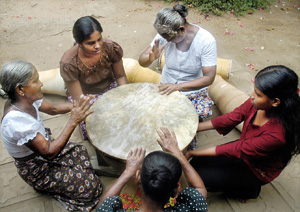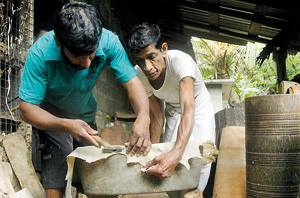We meet Japin Nona of Veyangoda, a veteran at the art of playing the raban (a traditional drum) as she prepares for the dawn of Avurudu . “I was just eight years old when I first started playing raban, and I learnt it from watching my aunt do the same. I used to love watching them playing raban,” she said, recalling her childhood.
It is the call of the Koha and the sound of raban that herald the Avurudu. Women dressed in their redde and hatte (cloth and jacket) playing raban is something everyone associates with the New Year, at least in the past.
The word ‘Rabana’ comes from South East Asia and the instrument is used in other countries like Thailand, Malaysia and even in Burma. It is believed that Sri Lankans received the instrument at the time when King Vijayaba married a Malaysian princess, Thilokasundarie. However, raban pada (rhythms) originated among rural folk here to give expression to village life and people’s emotions.
One of the traditonal avurudu games includes a group of about four to six woman sitting around the large raban, and beating it rhythmically to a specific beat that imitates a raban pada.
 Although traditionally the raban is played with the flat of the palms, experts use innovative methods using their elbows, forehead and sometimes bundles of ekels. “Playing the raban gains significance during avurudu because most of the raban pada are based on Avurudu practices,” says visiting lecturer for University of the Visual and Performing Arts Chandrakanthi Shilpadipathi. In villages Raban pada are also played during weddings and other social events, including the event of a young girl attaining age. Although traditionally the raban is played with the flat of the palms, experts use innovative methods using their elbows, forehead and sometimes bundles of ekels. “Playing the raban gains significance during avurudu because most of the raban pada are based on Avurudu practices,” says visiting lecturer for University of the Visual and Performing Arts Chandrakanthi Shilpadipathi. In villages Raban pada are also played during weddings and other social events, including the event of a young girl attaining age.
Raban player P. A. D. Thilakaratna, who has played the raban for nearly 30 years says it is mainly played by women folk.
Japin Nona’s friend, K. P. Kamalawathi chips in to say she has participated in many raban competitions and that they used to rehearse so that would all play to the same rhythm.
But there is general consensus among them that the demand for their services and appreciation for their skill is fast fading away. “My grandchildren are not interested in learning this traditional art. Earlier people used to invite us to play at weddings. Now hardly anyone does. Sometimes we get together and play for our grandchildren, so that they will try to appreciate this traditional art,” says Japin Nona.
“Though it was played earlier at weddings and the custom exists in remote villages, society has changed and most opt to celebrate weddings at hotels. Most women go to work and they have no time for traditional recreational activities. The television is their only source of entertainment,” says performing arts lecturer Chandrakanthi. - Pix by M.A. Pushpa Kumara
It’s hard to make and even harder to sell
A good rabana will last for nearly 25 years, but making it is not easy, as it demands a lot of physical energy, say the craftsmen who still continue with their traditional trade.
 Sooriya, margosa, jak and mara trees are used to make the bench rabana. Liyanage Pradeep Prasanna from Heiyanthuduwa who has been making raban for nearly 15 years says that he buys the timber from the State Timber Corporation, but at times it is so costly that he is unable to afford it. Sooriya, margosa, jak and mara trees are used to make the bench rabana. Liyanage Pradeep Prasanna from Heiyanthuduwa who has been making raban for nearly 15 years says that he buys the timber from the State Timber Corporation, but at times it is so costly that he is unable to afford it.
The second burden is transportation, as it is costly to hire vehicles to bring the logs to their workshop.
The process of making the raban starts with the huge log being divided into two and circles being drawn with a compass. Then a hole is made with the help of a chisel. This demands a lot of patience and concentration. A long saw is put through the hole and the frame is made with the help of two people. It takes almost a day to make the frame,” says Prasanna.
The last stage is tanning the hide (usually a goat skin) in lime to be used on the face of the rabana. The hide is dried and attached to the frame carefully. “It takes nearly two weeks to complete the rabana as everything is done manually,” says Prasanna adding that there is hardly any demand for raban except during the Avurudu and Vesak season.
M. Rammika Upul Kumara from Veyangoda who has a more mechanized operation, says that a medium sized rabana costs nearly Rs. 6, 500. It is expensive so many usually hire a raban for an occassion. It is very risky to enter this profession now as there is no demand. My children will not follow my footsteps I am certain of that,” he says emphatically. |
|

 Although traditionally the raban is played with the flat of the palms, experts use innovative methods using their elbows, forehead and sometimes bundles of ekels. “Playing the raban gains significance during avurudu because most of the raban pada are based on Avurudu practices,” says visiting lecturer for University of the Visual and Performing Arts Chandrakanthi Shilpadipathi. In villages Raban pada are also played during weddings and other social events, including the event of a young girl attaining age.
Although traditionally the raban is played with the flat of the palms, experts use innovative methods using their elbows, forehead and sometimes bundles of ekels. “Playing the raban gains significance during avurudu because most of the raban pada are based on Avurudu practices,” says visiting lecturer for University of the Visual and Performing Arts Chandrakanthi Shilpadipathi. In villages Raban pada are also played during weddings and other social events, including the event of a young girl attaining age. Sooriya, margosa, jak and mara trees are used to make the bench rabana. Liyanage Pradeep Prasanna from Heiyanthuduwa who has been making raban for nearly 15 years says that he buys the timber from the State Timber Corporation, but at times it is so costly that he is unable to afford it.
Sooriya, margosa, jak and mara trees are used to make the bench rabana. Liyanage Pradeep Prasanna from Heiyanthuduwa who has been making raban for nearly 15 years says that he buys the timber from the State Timber Corporation, but at times it is so costly that he is unable to afford it. 